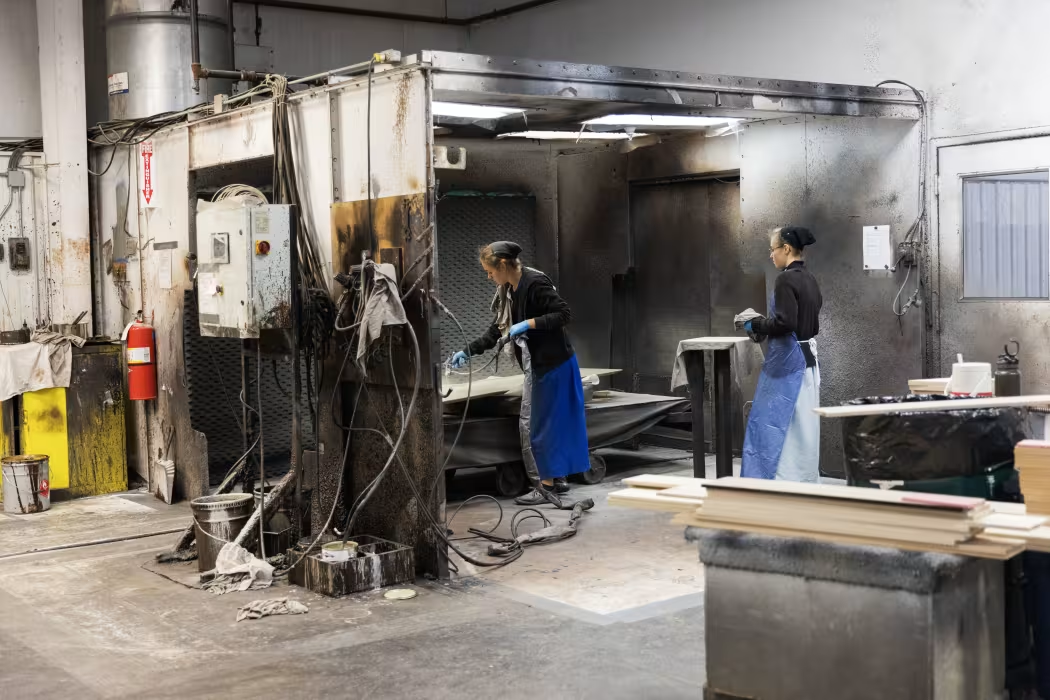
What the Amish Can Teach America About Economic Mobility
By Scott Calvert | Photographs by Maddie McGarvey for WSJ
Roughly half the residents of Holmes County, Ohio, are Amish. Many natives remain partly because of the Amish tradition of staying near one’s community.
MOUNT HOPE, Ohio—At age 32, Ryan Hershberger has achieved success far beyond his modest roots.
He launched a furniture business with two cousins a decade ago and now owns a company that distributes its solid-wood tables and chairs nationwide. From a second-floor corner office, he presides over the 65,000-square-foot factory floor where dozens of workers assemble the pieces. One is his dad, Wyman Hershberger, 67, a carpenter who expresses pride over his son’s rise.
“He’s a go-getter,” he said, “and that’s what it takes.”
It helps that Ryan Hershberger lives and works in Holmes County, Ohio, America’s standout for economic mobility by one measure. Millennials there are doing better than the generation ahead of them.
Young people across the nation are contending with crushing housing costs and student-loan debt. Only recently have they seen a burst of financial stability after struggling to keep up with previous generations.
Something different has been happening in the rolling, green hills of Holmes County.
 Ryan Hershberger launched a furniture business with two cousins a decade ago.
Ryan Hershberger launched a furniture business with two cousins a decade ago.
Between 2005 and 2019, average household income in Holmes County rose 24% for 27-year-olds raised in lower-income homes—from roughly $36,000 to $45,000 in inflation-adjusted 2023 dollars. That puts millennials who are now in their early 30s far ahead of their Gen X counterparts when they were that age.
Holmes County had the biggest relative jump for any U.S. county where such 27-year-olds in 2005 already earned at least the median household income, according to a Wall Street Journal analysis of data released this year by a team of Harvard University economists.
Younger millennials from middle- and high-income families here also notched big gains, according to the data.
Raj Chetty, a Harvard economist, and his fellow researchers used anonymized census and tax data to follow millions of Americans from childhood to adulthood. Their aim: to better understand economic mobility—the ability to move up the income ladder.
‘Extreme networking effect’
Holmes County isn’t a wealthy place. Median household income is about $73,000, near the roughly $75,000 median for the U.S., census figures show. But its status as an economic mobility darling is notable because by some standards it should be struggling. It sits far from any interstates and lacks urban centers. Roughly half of its 44,000 residents are Amish, part of a Christian community that eschews varying degrees of modern technology. And because Amish children typically stop school after eighth grade, the county’s educational attainment among 25-year-olds ranks last in Ohio.
 Workers staining furniture at Canal Dover Furniture & Treecraft Furniture in Mount Hope, Ohio.
Workers staining furniture at Canal Dover Furniture & Treecraft Furniture in Mount Hope, Ohio.
What’s going on? Economists and local business leaders believe much of the progress stems from entrepreneurial growth fueled by cooperation and innovation, all buttressed by tight family and community ties. Mark Partridge, an Ohio State University economist who has studied Holmes County, points to an “extreme networking effect,” where companies—and cousins—routinely help each other out.
While other counties can’t necessarily replicate this cocktail, they can draw on key ingredients, Partridge said. “There’s no real strong reason you have to be Amish,” he said. “You can have a tight social network with effective social organizations, chambers of commerce, business organizations, other kind of nonprofits.”
While rural areas are often hampered by young talent moving away for better job opportunities, many Holmes County natives remain, held in part by the Amish tradition of staying near one’s community. Job growth helps too. A third of workers employed in Holmes County commute from elsewhere, Partridge said.
Community bonds underpin Holmes County’s economy. Steve Miller, 31, started Grand Design Roofing in his 20s with a partner. Their Covid-era boom is over, he said, but business is still robust enough to sometimes overextend him and his six workers.
“If we’ve got plenty of jobs, I just go to my competitor and I give him a couple jobs,” said Miller, who is Amish. “I’m here so my employees can make a good, honest living…. I’m not here to collect all the wealth I can absolutely collect.”
Miller said he sometimes deposits money into a fund that aids local residents with hospital bills and other needs; benefit fundraisers are a staple of community life here.
The county’s rising prosperity is rooted in a broad shift from agriculture to small-scale manufacturing that began decades ago. As falling milk prices made dairy farming increasingly untenable, many families sought new ways to earn a living, said Marcus Yoder, who directs the local Amish & Mennonite Heritage Center.
“When they moved off of farms, many of them established small businesses that grew. And this cohort [in their early 30s] is riding the wave of that growth in a tremendous way,” he said.
Generational gains
Chris Keim, 31, grew up poor on a 95-acre Holmes County dairy farm. His father worked at a sawmill for extra income and once sold two aging cows to pay for a family vacation to Niagara Falls.
Keim, who is Amish, didn’t see farming as a viable option and had a series of manual-labor jobs after leaving school after eighth grade. He spent most of his 20s in the furniture business. A few years ago, an uncle hired him for sales and marketing at his outdoor furniture business, which began as a pumpkin stand and now mostly sells locally made items. The vast Kauffman Lawn Furniture showroom where Keim works today was until a few years ago a hayfield, one of many local fields paved over for commerce.
 Wyman Hershberger works at his son’s company, Canal Dover Furniture.
Wyman Hershberger works at his son’s company, Canal Dover Furniture.
This year Keim expects to make around $120,000, more than double his 61-year-old father’s current pay at a lumber company. Keim and his wife own five rental homes and recently sold several others to finance their second adoption, he said. To him, it is all about hard work, guided by his values and religion. “We believe that God has given us everything that we have, and we are going to make the most of every opportunity,” he added.
Since 2014, the Holmes County Economic Development Council, a publicly and privately funded nonprofit, has supported 38 construction or expansion projects totaling more than $160 million in capital investment, said Executive Director Mark Leininger. Those projects have yielded more than 1,100 new full-time jobs paying about $54,000 on average.
During a tour in Leininger’s pickup, he pointed out several factories that have sprouted up. He cruised along busy Route 39, where tourists lured by the landscape and Amish culture share the road with horse-drawn buggies.
“It’s crazy how much growth has taken place in the last 10 years, mainly manufacturing,” Leininger said.
 Chris Keim, who grew up on a 95-acre dairy farm, works at Kauffman Lawn Furniture.
Chris Keim, who grew up on a 95-acre dairy farm, works at Kauffman Lawn Furniture.
Entrepreneurial ambition
His truck passed Cafe Chrysalis. Crystal Bontrager, 30, opened the homey cafe in 2022, and has expanded to 3,000 square feet and a staff of 17.
“Work ethic has been very much taught and kind of drilled into us at a young age,” Bontrager said. One of her childhood chores: washing clothes with a hand-wringer.
Raised Amish and now part of a nondenominational church, she was influenced by entrepreneurs like her late father, who ran an excavating business. The cafe isn’t making her rich, she said, but sales are steady. Locals willing to pay $5.25 for a latte are her core customers; on a recent day, women in bonnets sat at several tables.
 Crystal Bontrager opened Cafe Chrysalis in 2022, and has expanded to 3,000 square feet and a staff of 17.
Crystal Bontrager opened Cafe Chrysalis in 2022, and has expanded to 3,000 square feet and a staff of 17.
Ryan Hershberger felt an early pull to own his own business, an ambition bolstered by his tightly knit community. In his teens, he worked at what is now Canal Dover, cycling through the furniture company’s finishing, shipping and other departments. When Hershberger left to start a new furniture venture called Treecraft with his cousins, an uncle provided his workshop and tools.
Treecraft’s debut order, 80 faux cabinet doors for a Los Angeles hotel, came from his former employer, Canal Dover. Hershberger later bought out his cousins and expanded Treecraft to 15 workers. A couple of years ago Canal Dover’s owners asked if he wanted to buy it, which Hershberger did for an undisclosed price using debt and equity.
He said some of his biggest competitors are his friends: “I go back to community, helping each other and being able to lean on each other to start a business and get into the market.”
 Holmes County’s rising prosperity is rooted in a broad shift from agriculture to small-scale manufacturing that began decades ago.
Holmes County’s rising prosperity is rooted in a broad shift from agriculture to small-scale manufacturing that began decades ago.
